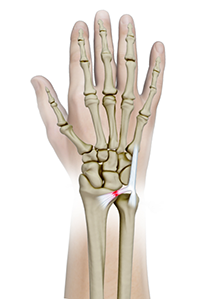
What is Triangular Fibrocartilage Complex (TFCC) Injury?
The triangular fibrocartilage complex, or TFCC, is a complex of cartilage and ligaments located near the outer region of the wrist, below the little finger. It serves to stabilize the wrist, allowing easy movement and shock-absorption. Sports activities or falls can damage or injure the TFCC, causing wrist pain and instability. The injured TFCC may also produce a clicking sound with certain wrist movements.
Causes of Triangular Fibrocartilage Complex Injury (TFCC)
- A fall on an outstretched wrist
- Excessive rotation or pulling on the wrist joint
Symptoms of Triangular Fibrocartilage Complex Injury (TFCC)
- Pain on the small finger side of the wrist
- Swelling in the wrist
- A clicking sound or feeling when moving the wrist
- Forearm bone instability
Diagnosis of Triangular Fibrocartilage Complex Injury (TFCC)
When you present to the clinic with symptoms of a TFCC injury your doctor will perform X-rays to detect any joint abnormalities, fractures or bone deformities. Your doctor may order an MRI to assess the extent of the injury and may use injections to confirm the diagnosis and/or deliver medications such as steroids to the area.
Treatment for Triangular Fibrocartilage Complex Injury (TFCC)
Treatment can be surgical or non-surgical. Non-surgical treatment options include:
- Rest and activity modification
- Immobilization in a splint or cast
- Physiotherapy
If non-surgical options fail to provide relief, your doctor may recommend surgery. TFCC injuries can be addressed by open or arthroscopic methods.
Arthroscopic TFCC debridement and/or repair: This is a minimally invasive procedure in which 2 to 3 small incisions of are made in the wrist. A slender viewing instrument called an arthroscope and other surgical instruments are inserted as needed. Most tears in the cartilage are addressed by debridement (removal of dead or damaged tissues). Occasionally, tears are sutured and reattached.
Open TFCC repair: Open repair may be necessary for complex tears. A larger incision is made over the wrist to gain a better view and access to the site of injury. Repair is based on the damage caused to the ligaments and cartilage. Ligaments and torn tissue may be reattached to the surrounding joint capsule or repaired down to bone. In chronic and degenerative injuries, the load on the TFCC side of the wrist can be decreased by shortening the ulna (bone of the forearm that attaches to the wrist).
Post-Operative Recovery of Triangular Fibrocartilage Complex Injury (TFCC)
After surgery, your wrist will be bandaged and should be kept elevated for 2 to 3 days. Your wrist will be placed in a splint for about 2 to 6 weeks. Your doctor may prescribe medication to relieve pain and discomfort. You can apply ice to reduce swelling. You will be taught strengthening and stretching exercises to regain range-of-motion of the wrist. Recovery is faster after arthroscopic surgery as compared to the open technique. Being minimally invasive, the arthroscopic procedure is associated with less post-procedural pain and scar formation.
Risks and Complications of Triangular Fibrocartilage Complex Injury Repair Surgery
Like most surgeries, TFCC repair surgeries may be associated with certain risks such as:
- Infection at the site of the surgery
- Nerve and tendon damage
- Swelling, stiffness, and scarring
Failure of repair
Related Topics
- Wrist Fracture
- Fractures of the Hand and Fingers
- Wrist Sprain
- Flexor Tendon Injuries
- Distal Radioulnar Joint (DRUJ) Arthritis
- Ulnar Nerve Compression in Guyon's Canal
- Scaphoid Facture
- Industrial Hand Trauma
- Distal Radius Osteotomy to Correct Mal-Union (Crooked Painful Wrist)
- Distal Intersection Syndrome
- Distal Biceps Avulsion
- Adult Forearm Fractures
- Arthritis of the Hand and Wrist
- Arthritis of the Thumb
- Ganglion Cyst
- Boutonniere Deformity
- Carpal Tunnel Syndrome
- De Quervain's Tendinosis
- Dupuytren's Contracture
- Hand Pain
- Hand Infections
- Trapeziometacarpal (TMC) Arthritis
- Wrist Injuries
- Wrist Tumors
- Boxer's Fracture
- Swan Neck Deformity
- Carpal Instability
- Bennett's Fracture
- Kienbock's Disease
- Scapholunate Dissociation
- Triscaphoid Joint Arthritis
- Ulnar Carpal Impaction
- Triangular Fibrocartilage Complex Injury (TFCC)
- Guyon's Canal Syndrome
- Hand Masses
- Distal Radioulnar Joint (DRUJ) Instability
- Work Related Hand Injuries
- Wrist Ligament Tear and Instability
- Metacarpophalangeal Joint Arthritis





